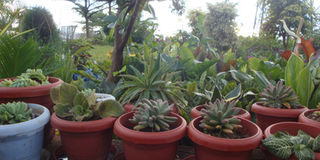Prime
Growing ornamental mini succulents

Mini succulents need as much sunshine as possible to grow well. Photo by Constance Obonyo
What you need to know:
Succulents are thick-leaved ornamental plants that resemble cactuses, but without the thorns. Just like cactuses, they can grow in dry conditions normally.
There are two types of succulents. The giant succulents and the mini succulents. Sometimes, mini succulents are more expensive than giant succulents, because they are slow-growing and are rare.
Joseph Kaka of Ngolobe Flower Plants on Mukwano Road, next to the lower Railway entrance, recommends three types of mini succulents. He recommends the Aeonium from the family of Crassulaceae, the Echeverias, also of the Crassulaceae family and the Opunta Microdasys of the cactus species.
“Mini succulents are for decoration. You can use them in conjunction with stones in rock gardens or in balcony gardens. If you can afford pots, plant them in pots. If you cannot, plant them in your garden,” Kaka says.
How to plant them
Propagate them using leaves, stem cuttings or by their roots. Kaka advises that if you want to use root cuttings, you need to cut specific areas before planting. To use the leaf, place it on the ground or plant it in the soil and it will root. To get stem cuttings, cut particular areas where buds are located and plant them. They will rot.
If you plant them in the garden, don’t space them. They look better squeezed into small spaces. They don’t need a lot of maintenance and at times, they will not need any watering at all. If you water them too much, they may rot and get destroyed. Water them once a week during the dry seasons. Don’t water them at all during the rainy seasons.
“The potting medium matters a lot for succulents. The soil must be sandy. Put 70 per cent sand at the bottom of the pot and normal soil on top of that,” says Kaka.
Maintainance
Mini succulents are slow-growing perennial plants and can last forever, if well maintained. Change the soil in the pot after one or two years, depending on the species of mini succulents. Trimming the roots as you change the soil is also important.
“There will be black roots, while others will be white. Trim the black roots, because they will have rotted. If you leave them, the rot will spread to the plant and destroy it,” says Kaka.
After trimming, leave it for some hours, so that the wound can dry, before re-potting it. The same goes for the cuttings. After getting a cutting, don’t plant it immediately. Wait a few hours, though a day would be preferable, before planting. If the wound does not dry and you plant the cutting, it may rot.
There will be no need for weeding or mulching, since the plants will be compacted together. You, however, will need to prune. Succulents grow suckers. Prune the suckers, so that the plant can become bigger and give a better bloom.
There will be no need for fertilizer either, but succulents need lime, in order for them to grow well. Acidic soil contains manure, while alkaline soil contains lime, which succulents need. Obtain lime from the supermarkets, but it is a little dear. If you know what it looks like, you can get it at negotiable rates from roadside nurseries. You can get a reasonable quantity for Shs2000 to Shs5000.
Sunshine
If you have potted your mini succulents, place them where they can receive enough sunshine. At least six hours of sunshine a day will suffice. So their positioning matters. If you place them in a shade, even though you may not water them, they will rot.
Place these ornamental potted plants on window sills, verandahs, balconies or backyards; and of course, outside, in your garden. Don’t place them inside the house, or they will rot.




